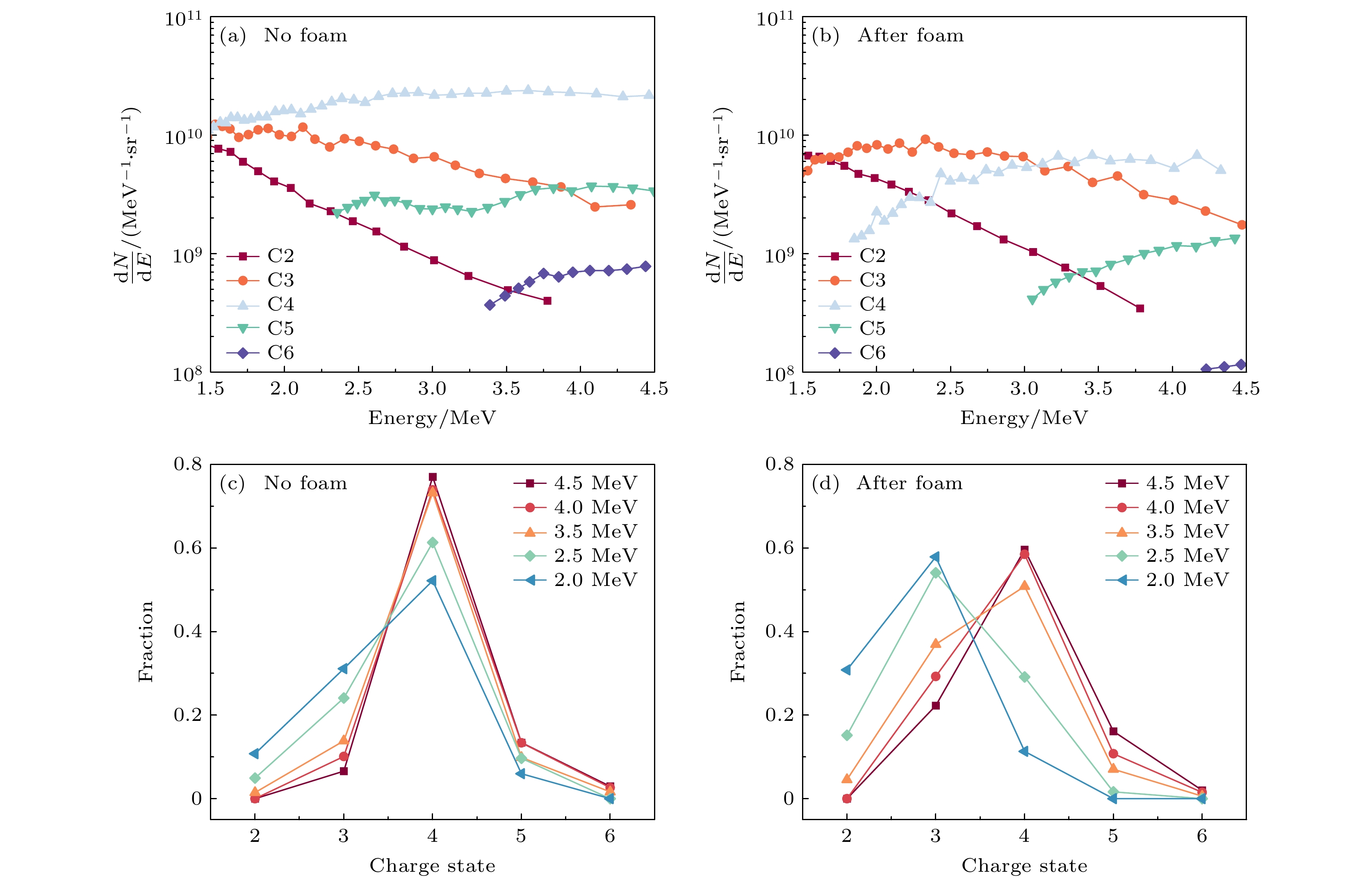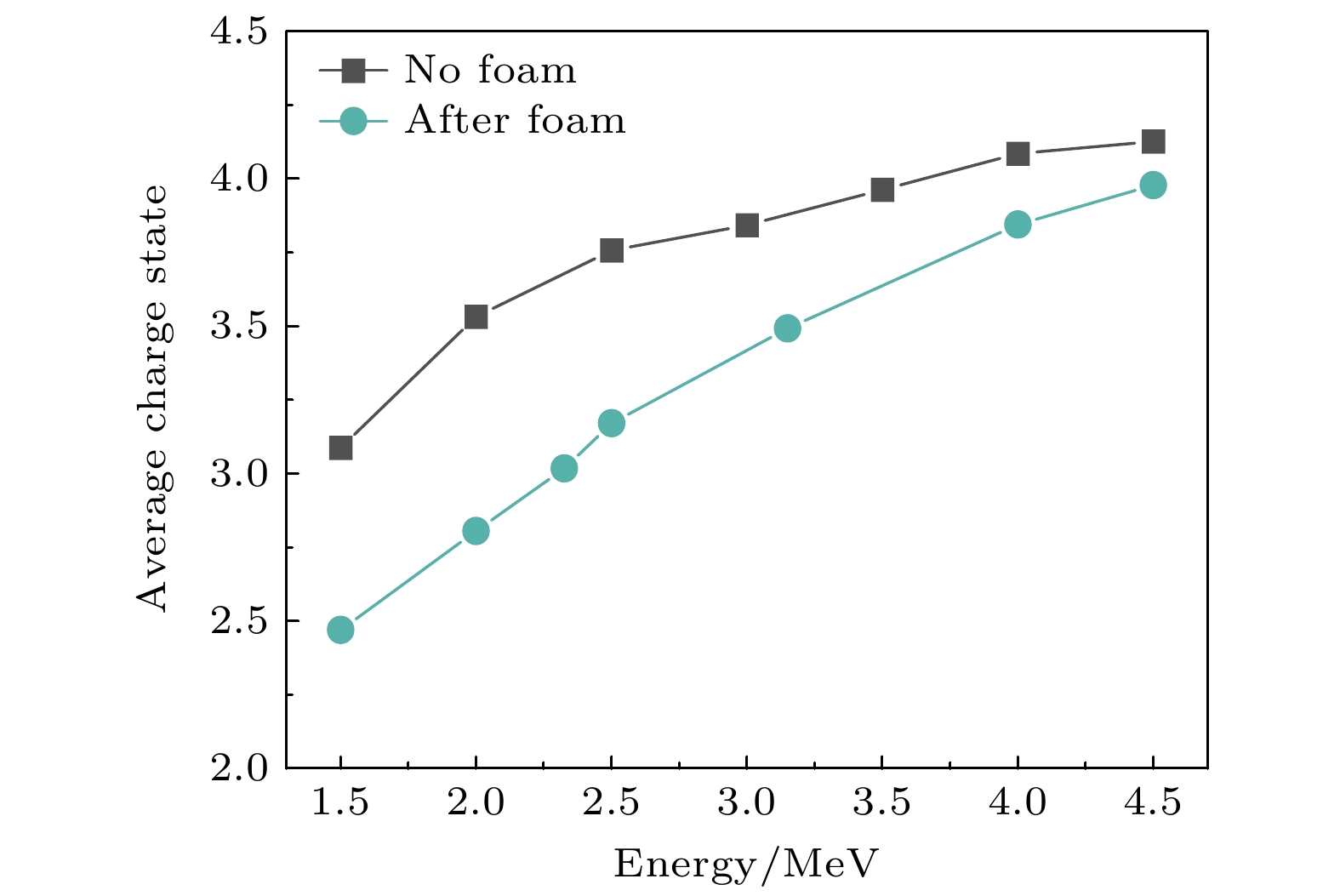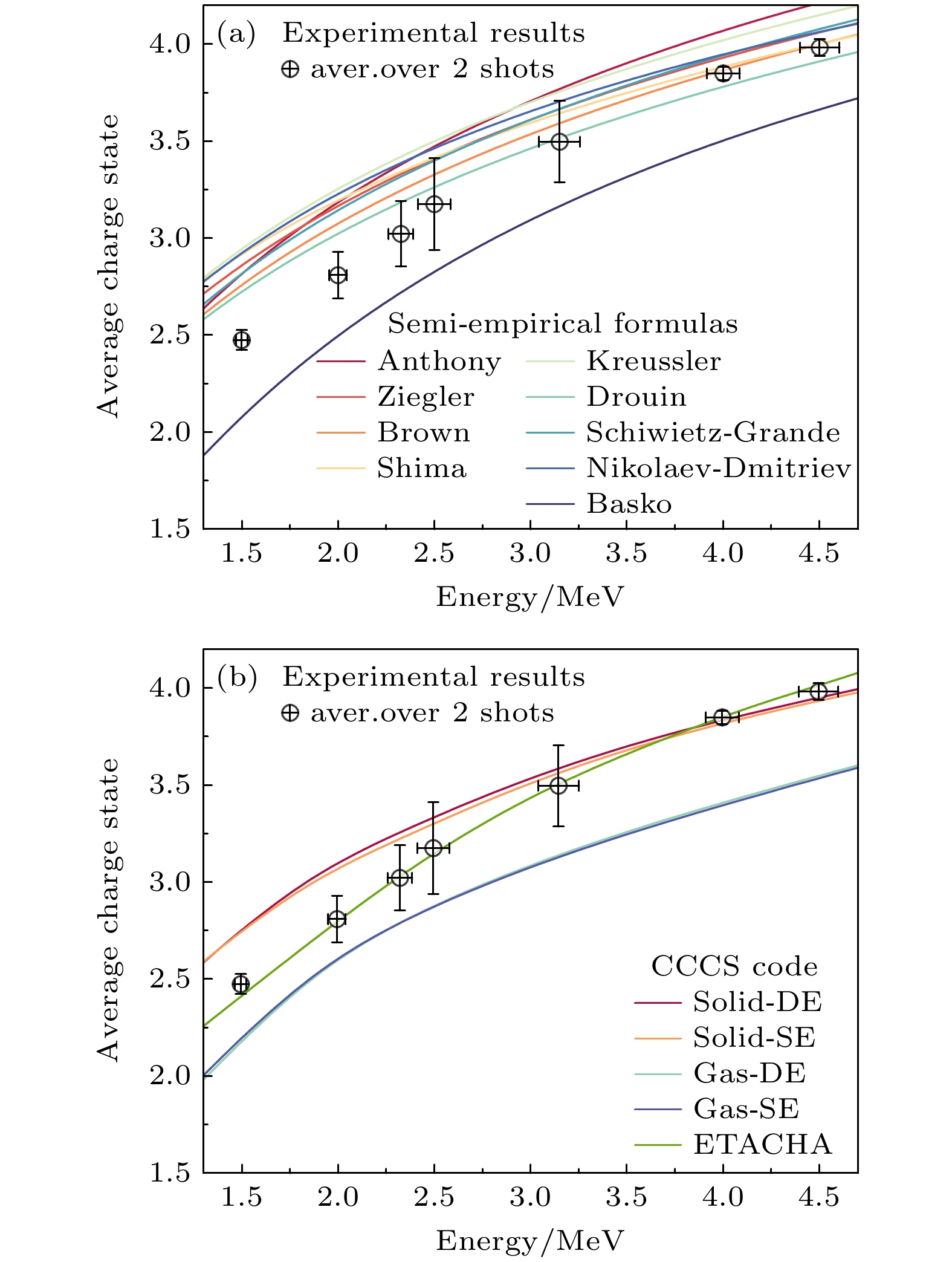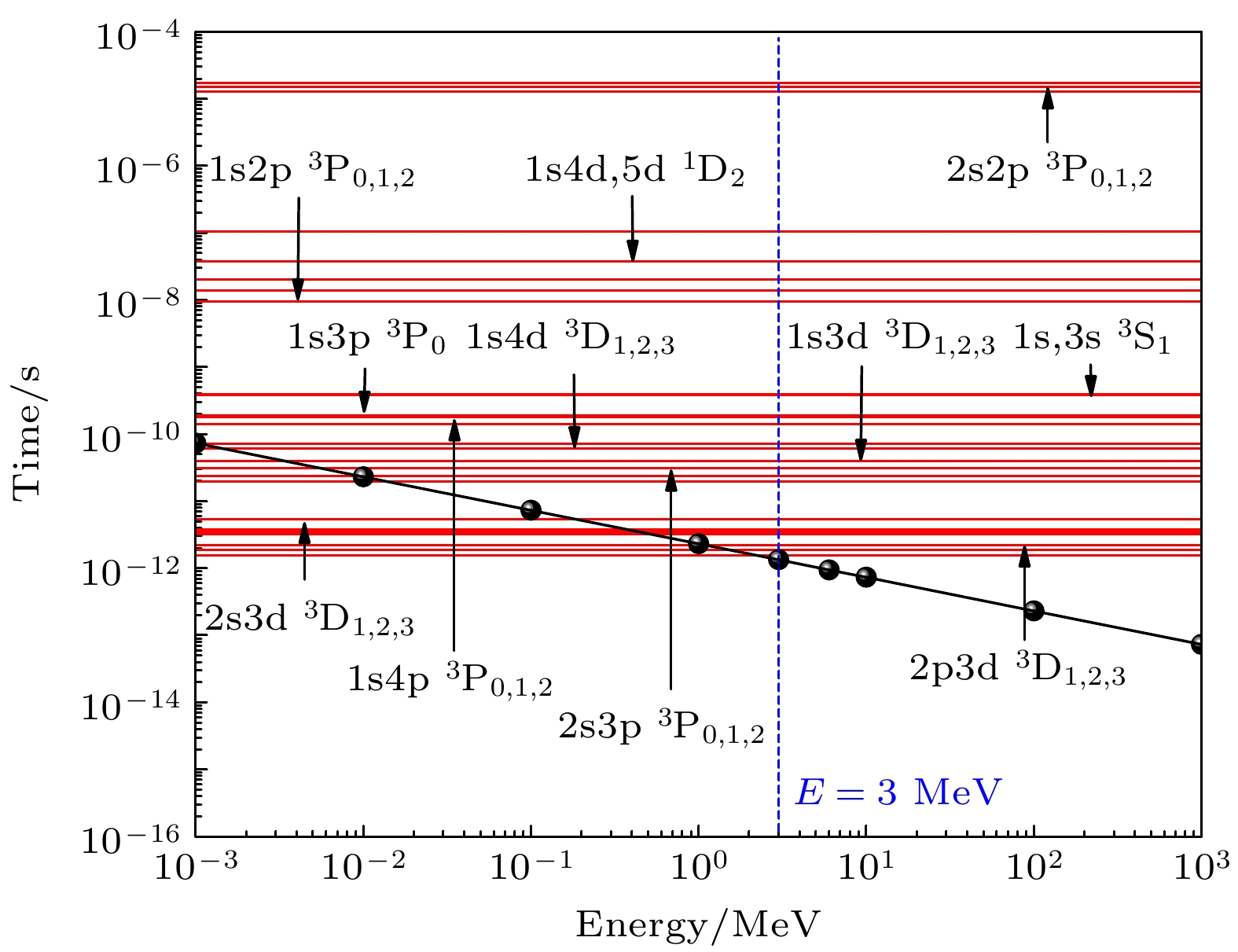-
离子与物质相互作用中的电荷转移过程研究对于离子束驱动高能量密度物理、材料离子辐照损伤、离子束电荷剥离技术等领域至关重要. 本文利用激光驱动靶背鞘层场加速机制产生了能量在数MeV量级的碳离子束, 测量了碳离子束穿过具有孔状结构的C9H16O8泡沫靶后的电荷态分布. 实验结果与理论对比发现, 只有同时考虑了电离、俘获、激发和退激等过程的速率方程结果与实验符合很好. 采用气体靶截面数据求解速率方程获得的平衡电荷态低估了实验值, 原因在于泡沫结构靶中固态纤维丝引起的靶密度效应导致离子电荷态升高. 当离子能量高于3 MeV以上时, 实验值与采用了固态靶截面数据的速率方程理论预期一致; 但在低能区出现明显偏差, 原因在于当入射能量小于3 MeV时, 离子激发态寿命小于碰撞时间尺度, 激发态电子在发生第二次碰撞之前退激发回到基态, 靶密度效应减弱, 平均电荷态降低, 实验结果与详细考虑了激发和退激过程的ETACHA程序预期吻合. 该工作为理解离子束与物质相互作用微观机制以及电荷转移模型检验提供了数据和参考.Charge transfer processes in ion-matter interactions are crucial for ion beam-driven high-energy density physics, material irradiation damage, and charge state stripping in accelerator techniques. Here we generate carbon ion beams in the MeV energy range through target normal sheath acceleration (TNSA) mechanism, and measure the average charge state of 1.5–4.5 MeV carbon ion beams passing through porous C9H16O8 foam with a volume density of 2 mg/cm3. The measured average charge states are compared with the average equilibrium charge-states predicted by semi-empirical formula and rate equation. The results show that the predictions from the rate equation that fully considers the ionization, capture, excitation, and de-excitation processes are in good agreement with experimental results. The prediction from the rate equation by using gas target cross-section data underestimates the experimental data, because the target density effect caused by the solid fiber filaments in the foam-structured target increases the ionization probability through frequent collisions, reduces the electron capture probability, and thus leads to an enhancement of ion charge states. In the projectile energy range above 3 MeV, the experimental data agree with the predictions from the rate equation using solid-target cross-section data. However, a significant deviation emerges in the energy region below 3 MeV due to the fact that in this energy range, the lifetime of ion excited states is shorter than the collisional time scale. In this case, excited electrons have time to de-excite the ground state before the second collision occurs. Consequently, the target density effects are weakened, and the charge states are reduced. The experimental results agree well with predictions from the ETACHA code that considers excitation and de-excitation processes in detail. This work provides the data and references for better understanding ion-matter interactions and distinguishing various charge exchange models.
-
Keywords:
- laser acceleration /
- carbon ion beam /
- charge transfer /
- target density effects
[1] Shima K, Kuno N, Yamanouchi M 1989 Phys. Rev. A 40 3557
 Google Scholar
Google Scholar
[2] Zhao Y T, Zhang Y N, Cheng R, He B, Liu C L, Zhou X M, Lei Y, Wang Y Y, Ren J R, Wang X, Chen Y H, Xiao G Q, Savin S M, Gavrilin R, Golubev A A, Hoffmann D H H 2021 Phys. Rev. Lett. 126 115001
 Google Scholar
Google Scholar
[3] Rothard H, Grandin J P, Jung M, Clouvas A, Rozet J P, Wünsch R 1997 Nucl. Instrum. Methods Phys. Res. Sect. B 132 359
 Google Scholar
Google Scholar
[4] Betz H D 1972 Rev. Mod. Phys. 44 465
 Google Scholar
Google Scholar
[5] Deutsch C, Maynard G 2016 Matter Radiat. Extremes 1 277
 Google Scholar
Google Scholar
[6] Gao J, Hu Z, Wu Y, Wang J, Sisourat N, Dubois A 2021 Matter Radiat. Extremes 6 014404
 Google Scholar
Google Scholar
[7] Erb W 1978 GSI Report GSI-P-78 (Darmstadt
[8] Ali R, Beiersdorfer P, Harris C L, Neill P A 2016 Phys. Rev. A 93 012711
 Google Scholar
Google Scholar
[9] Ma X W, Zhang S F, Wen W Q, Huang Z K, Hu Z M, Guo D L, Gao J W, Najjari B, Xu S Y, Yan S C, Yao K, Zhang R T, Gao Y, Zhu X L 2022 Chin. Phys. B 31 093401
 Google Scholar
Google Scholar
[10] Kawata S, Karino T, Ogoyski A I 2016 Matter Radiat. Extremes 1 89
 Google Scholar
Google Scholar
[11] Hofmann I 2018 Matter Radiat. Extremes 3 1
 Google Scholar
Google Scholar
[12] Zhao Q, Cao S C, Liu M, Sheng X K, Wang Y R, Zong Y, Zhang X M, Jing Y, Cheng R, Zhao Y T, Zhang Z M, Du Y C, Gai W 2016 Nucl. Instrum. Methods Phys. Res. Sect. A 832 144
 Google Scholar
Google Scholar
[13] Zhao Y, Zhang Z, Gai W, Du Y, Cao S, Qiu J, Zhao Q, Cheng R, Zhou X, Ren J, Huang W, Tang C, Xu H, Zhan W 2016 Laser Part. Beams 34 338
 Google Scholar
Google Scholar
[14] Zhao Y T, Cheng R, Wang Y Y, Zhou X M, Lei Y, Sun Y B, Xu G, Ren J R, Sheng L N, Zhang Z M, Xiao G Q 2014 High Power Laser Science and Engineering. 2 e39
 Google Scholar
Google Scholar
[15] Bohr N 1941 Phys. Rev. 59 270
 Google Scholar
Google Scholar
[16] Anthony J M, Lanford W A 1892 Phys. Rev. A 25 1868
 Google Scholar
Google Scholar
[17] Ziegler J F, Biersack J P 1985 Treatise on Heavy-Ion Science 6 93
 Google Scholar
Google Scholar
[18] Kreussler S, Varelas C, Brandt W 1981 Phys. Rev. B 23 82
 Google Scholar
Google Scholar
[19] Nikolaev V S, Dmitriev I S 1968 Phys. Lett. A 28 277
 Google Scholar
Google Scholar
[20] Brown M D, Moak C D 1972 Phys. Rev. B 6 90
 Google Scholar
Google Scholar
[21] Shima K, Ishihara T, Mikumo T 1982 Nucl. Instrum. Methods Phys. Res. 200 605
 Google Scholar
Google Scholar
[22] To K X, Drouin R 1976 Phys. Scr. 14 277
 Google Scholar
Google Scholar
[23] Schiwietz G, Grande P L 2001 Nucl. Instrum. Methods Phys. Res. Sect. B 175 125
[24] Basko M M 1984 Sov. J. Plasma Phys. 10 689
[25] Northcliffe L C 1960 Phys. Rev. 120 1744
 Google Scholar
Google Scholar
[26] Gauthier M, Chen S N, Levy A, Audebert P, Blancard C, Ceccotti T, Cerchez M, Doria D, Floquet V, Lamour E, Peth C, Romagnani L, Rozet J P, Scheinder M, Shepherd R, Toncian T, Vernhet D, Willi O, Borghesi M, Faussurier G, Fuchs J 2013 Phys. Rev. Lett. 110 135003
 Google Scholar
Google Scholar
[27] Tolstikhina I Y, Shevelko V P 2018 Phys.-Usp. 61 247
 Google Scholar
Google Scholar
[28] Lassen N O 1950 Phys. Rev. 79 1016
 Google Scholar
Google Scholar
[29] Bohr N, Lindhard J 1954 Dan. Mat. Fys. Medd. 28 1
 Google Scholar
Google Scholar
[30] Shevelko V P, Rosmej O, Tawara H, Tolstikhina I Y 2004 J. Phys. B: At. Mol. Opt. Phys. 37 201
 Google Scholar
Google Scholar
[31] Shevelko V P, Tawara H, Ivanov O V, Miyoshi T, Noda K, Sato Y, Subbotin A V, Tolstikhina I Y 2005 J. Phys. B: At. Mol. Opt. Phys. 38 2675
 Google Scholar
Google Scholar
[32] Kistler S S 1931 Nature 127 741
 Google Scholar
Google Scholar
[33] Rosmej O N, Suslov N, Martsovenko D, Vergunova G, Borisenko N, Orlov N, Rienecker T, Klir D, Rezack K, Orekhov A, Borisenko L, Krousky E, Pfeifer M, Dudzak R, Maeder R, Schaechinger M, Schoenlein A, Zaehter S, Jacoby J, Limpouch J, Ullschmied J, Zhidkov N 2015 Plasma Phys. Control. Fusion 57 094001
 Google Scholar
Google Scholar
[34] Ren J R, Deng Z G, Qi W, Chen B Z, Ma B B, Wang X, Yin S, Feng J H, Liu W, Xu Z F, Hoffmann D H H, Wang S Y, Fan Q P, Cui B, He S K, Cao Z R, Zhao Z Q, Cao L F, Gu Y Q, Zhu S P, Cheng R, Zhou X M, Xiao G Q, H W, Zhang Y H, Zhang Z, Li Y T, Wu D, Zhou W M, Zhao Y T 2020 Nat. Commu. 11 5157
 Google Scholar
Google Scholar
[35] Ma B B, Ren J R, Wang S Y, Hoffmann D H H, Deng Z G, Qi W, Wang X, Yin S, Feng J H, Fan Q P, Liu W, Xu Z F, Chen Y, Cui B, He S K, Cao Z R, Zhao Z Q, Gu Y Q, Zhu S P, Cheng R, Zhou X M, Xiao G Q, Zhao H W, Zhang Y H, Zhang Z, Li Y T, Xu X, Wei W Q, Chen B Z, Zhang S Z, Hu Z M, Liu L R, Li F F, Xu H, Zhou W M, Cao L F, Zhao Y T 2021 Astrophys. J. 920 106
 Google Scholar
Google Scholar
[36] Renner O, Klimo O, Krus K, Nicolaï P, Poletaeva A, Bukharskii N, Tikhonchuk V T 2025 Matter Radiat. Extremes 10 037403
 Google Scholar
Google Scholar
[37] Braenzel J, Andreev A A, Platonov K, Klingsporn K, Ehrentraut L, Sandner W, Schnürer M 2015 Phys. Rev. Lett. 114 124801
 Google Scholar
Google Scholar
[38] Henig A, Steinke S, Schnürer M, Sokollik T, Hörlein R, Kiefer D, Jung D, Schreiber J, Hegelich B M, Yan X Q, Meyerter V J, Tajima T, Nickles P V, Sandner W, Habs D 2009 Phys. Rev. Lett. 103 245003
 Google Scholar
Google Scholar
[39] Braenzel J, Barriga-Carrasco M D, Morales R, Schnürer M 2018 Phys. Rev. Lett. 120 184801
 Google Scholar
Google Scholar
[40] 朱军高, 卢海洋, 赵媛, 赖美福, 古永力, 徐世祥, 周沧涛 2022 物理学报 71 194102
 Google Scholar
Google Scholar
Zhu J G, Lu H Y, Zhao Y, Lai M F, Gu Y L, Xu S X, Zhou C T 2022 Acta Phys. Sin. 71 194102
 Google Scholar
Google Scholar
[41] Zhao S A, Lin C, Chen J E, Ma W J, Wang J J, Yan X Q 2016 Chin. Phys. Lett. 33 035202
 Google Scholar
Google Scholar
[42] Ren J R, Ma B B, Liu L R, et al. 2023 Phys. Rev. Lett. 130 095101
 Google Scholar
Google Scholar
[43] Ma B B, Ren J R, Liu L R, Wei W Q, Chen B Z, Zhang S Z, Xu H, Hu Z M, Li F F, Wang X, Li W X, Li Q Y, Yin S, Feng J H, Zhou X M, Gao Y F, Li Y, Shi X H, Li J X, Ren X G, Xu Z F, Deng Z G, Qi W, Wang S Y, Fan Q P, Cui B, Wang W W, Yuan Z Q, Teng J, Wu Y C, Cao Z R, Zhao Z Q, Gu Y Q, Cao L F, Zhu S P, Cheng R, Lei Y, Wang Z, Zhou Z X, Xiao G Q, Zhao H W, Hoffmann D H H, Zhou W M, Zhao Y T 2024 Phys. Rev. A 109 042810
 Google Scholar
Google Scholar
[44] Hattass M, Schenkel T, Hamza A V, Barnes A V, Newman M W, McDonald J W, Niedermayr T R, Machicoane G A, Schneider D H 1999 Phys. Rev. Lett. 82 4795
 Google Scholar
Google Scholar
[45] Charge changing cross sections code, Novikov N V http://cdfe.sinp.msu.ru/services/cccc/htm/ [2024-7-28]
[46] Novikov N V, Teplova Y A 2014 Phys. Lett. A 378 1286
 Google Scholar
Google Scholar
[47] Rozet J P, Stephan C, Vemhet D 1996 Nucl. Instrum. Methods Phys. Res. Sect. B 107 67
 Google Scholar
Google Scholar
[48] Tarasov O B, Bazin D 2008 Nucl. Instrum. Methods Phys. Res. Sect. B 266 4657
 Google Scholar
Google Scholar
[49] Lamour E, Fainstein P D, Galassi M, Prigent C, Ramirez C A, Rivarola R D, Rozet J P, Trassinelli M, Vernhet D 2015 Phys. Rev. A 92 042703
 Google Scholar
Google Scholar
[50] Manai S, Salhi D E, Nasr S B, Jelassi H 2022 Res. Phys. 37 105487
 Google Scholar
Google Scholar
-
图 1 皮秒激光聚焦在铜箔上, 通过TNSA机制产生强流碳离子束. 使用与IP耦合的双通道TPS记录穿过泡沫靶和空靶的碳离子能谱
Fig. 1. Experimental setup. A picosecond laser is focused onto a copper foil, generating an intense carbon ion beam through the TNSA mechanism. The energy spectra of carbon ions passing through the foam target and the empty hole are measured with a dual-channel TPS coupled to the IP.
图 2 激光加速的碳离子分布 (a) 穿过空靶的能谱分布; (b) 穿过泡沫靶的能谱分布; (c) 穿过空靶的电荷分布; (d) 穿过泡沫靶的电荷分布
Fig. 2. Carbon ions distribution of laser-accelerated: (a) The energy spectra of passing through without target; (b) the energy spectra of passing through foam target; (c) charge state distribution of passing through without foam; (d) charge state distribution of passing through foam target.
图 4 测量的平均电荷态与理论预测值的比较 (a)与半经验模型比较; (b)与通过求解速率方程得出的预测值的比较. 实验数据是两发次的平均值, 其中能量误差为TPS对各电荷态碳离子能量分辨的最小值, 电荷态误差源于实验统计误差和发次抖动误差
Fig. 4. Comparison of measured average charge states with theoretical predictions: (a) The comparison with semiempirical models; (b) the comparison with predictions through solving rate equations. The experimental data are averaged over two shots, the error bars of energy represent the energy resolution of the TPS for the ion species that has the lowest resolution, the error bars of the average charge state originate from the statistical errors and shot-to-shot fluctuations
-
[1] Shima K, Kuno N, Yamanouchi M 1989 Phys. Rev. A 40 3557
 Google Scholar
Google Scholar
[2] Zhao Y T, Zhang Y N, Cheng R, He B, Liu C L, Zhou X M, Lei Y, Wang Y Y, Ren J R, Wang X, Chen Y H, Xiao G Q, Savin S M, Gavrilin R, Golubev A A, Hoffmann D H H 2021 Phys. Rev. Lett. 126 115001
 Google Scholar
Google Scholar
[3] Rothard H, Grandin J P, Jung M, Clouvas A, Rozet J P, Wünsch R 1997 Nucl. Instrum. Methods Phys. Res. Sect. B 132 359
 Google Scholar
Google Scholar
[4] Betz H D 1972 Rev. Mod. Phys. 44 465
 Google Scholar
Google Scholar
[5] Deutsch C, Maynard G 2016 Matter Radiat. Extremes 1 277
 Google Scholar
Google Scholar
[6] Gao J, Hu Z, Wu Y, Wang J, Sisourat N, Dubois A 2021 Matter Radiat. Extremes 6 014404
 Google Scholar
Google Scholar
[7] Erb W 1978 GSI Report GSI-P-78 (Darmstadt
[8] Ali R, Beiersdorfer P, Harris C L, Neill P A 2016 Phys. Rev. A 93 012711
 Google Scholar
Google Scholar
[9] Ma X W, Zhang S F, Wen W Q, Huang Z K, Hu Z M, Guo D L, Gao J W, Najjari B, Xu S Y, Yan S C, Yao K, Zhang R T, Gao Y, Zhu X L 2022 Chin. Phys. B 31 093401
 Google Scholar
Google Scholar
[10] Kawata S, Karino T, Ogoyski A I 2016 Matter Radiat. Extremes 1 89
 Google Scholar
Google Scholar
[11] Hofmann I 2018 Matter Radiat. Extremes 3 1
 Google Scholar
Google Scholar
[12] Zhao Q, Cao S C, Liu M, Sheng X K, Wang Y R, Zong Y, Zhang X M, Jing Y, Cheng R, Zhao Y T, Zhang Z M, Du Y C, Gai W 2016 Nucl. Instrum. Methods Phys. Res. Sect. A 832 144
 Google Scholar
Google Scholar
[13] Zhao Y, Zhang Z, Gai W, Du Y, Cao S, Qiu J, Zhao Q, Cheng R, Zhou X, Ren J, Huang W, Tang C, Xu H, Zhan W 2016 Laser Part. Beams 34 338
 Google Scholar
Google Scholar
[14] Zhao Y T, Cheng R, Wang Y Y, Zhou X M, Lei Y, Sun Y B, Xu G, Ren J R, Sheng L N, Zhang Z M, Xiao G Q 2014 High Power Laser Science and Engineering. 2 e39
 Google Scholar
Google Scholar
[15] Bohr N 1941 Phys. Rev. 59 270
 Google Scholar
Google Scholar
[16] Anthony J M, Lanford W A 1892 Phys. Rev. A 25 1868
 Google Scholar
Google Scholar
[17] Ziegler J F, Biersack J P 1985 Treatise on Heavy-Ion Science 6 93
 Google Scholar
Google Scholar
[18] Kreussler S, Varelas C, Brandt W 1981 Phys. Rev. B 23 82
 Google Scholar
Google Scholar
[19] Nikolaev V S, Dmitriev I S 1968 Phys. Lett. A 28 277
 Google Scholar
Google Scholar
[20] Brown M D, Moak C D 1972 Phys. Rev. B 6 90
 Google Scholar
Google Scholar
[21] Shima K, Ishihara T, Mikumo T 1982 Nucl. Instrum. Methods Phys. Res. 200 605
 Google Scholar
Google Scholar
[22] To K X, Drouin R 1976 Phys. Scr. 14 277
 Google Scholar
Google Scholar
[23] Schiwietz G, Grande P L 2001 Nucl. Instrum. Methods Phys. Res. Sect. B 175 125
[24] Basko M M 1984 Sov. J. Plasma Phys. 10 689
[25] Northcliffe L C 1960 Phys. Rev. 120 1744
 Google Scholar
Google Scholar
[26] Gauthier M, Chen S N, Levy A, Audebert P, Blancard C, Ceccotti T, Cerchez M, Doria D, Floquet V, Lamour E, Peth C, Romagnani L, Rozet J P, Scheinder M, Shepherd R, Toncian T, Vernhet D, Willi O, Borghesi M, Faussurier G, Fuchs J 2013 Phys. Rev. Lett. 110 135003
 Google Scholar
Google Scholar
[27] Tolstikhina I Y, Shevelko V P 2018 Phys.-Usp. 61 247
 Google Scholar
Google Scholar
[28] Lassen N O 1950 Phys. Rev. 79 1016
 Google Scholar
Google Scholar
[29] Bohr N, Lindhard J 1954 Dan. Mat. Fys. Medd. 28 1
 Google Scholar
Google Scholar
[30] Shevelko V P, Rosmej O, Tawara H, Tolstikhina I Y 2004 J. Phys. B: At. Mol. Opt. Phys. 37 201
 Google Scholar
Google Scholar
[31] Shevelko V P, Tawara H, Ivanov O V, Miyoshi T, Noda K, Sato Y, Subbotin A V, Tolstikhina I Y 2005 J. Phys. B: At. Mol. Opt. Phys. 38 2675
 Google Scholar
Google Scholar
[32] Kistler S S 1931 Nature 127 741
 Google Scholar
Google Scholar
[33] Rosmej O N, Suslov N, Martsovenko D, Vergunova G, Borisenko N, Orlov N, Rienecker T, Klir D, Rezack K, Orekhov A, Borisenko L, Krousky E, Pfeifer M, Dudzak R, Maeder R, Schaechinger M, Schoenlein A, Zaehter S, Jacoby J, Limpouch J, Ullschmied J, Zhidkov N 2015 Plasma Phys. Control. Fusion 57 094001
 Google Scholar
Google Scholar
[34] Ren J R, Deng Z G, Qi W, Chen B Z, Ma B B, Wang X, Yin S, Feng J H, Liu W, Xu Z F, Hoffmann D H H, Wang S Y, Fan Q P, Cui B, He S K, Cao Z R, Zhao Z Q, Cao L F, Gu Y Q, Zhu S P, Cheng R, Zhou X M, Xiao G Q, H W, Zhang Y H, Zhang Z, Li Y T, Wu D, Zhou W M, Zhao Y T 2020 Nat. Commu. 11 5157
 Google Scholar
Google Scholar
[35] Ma B B, Ren J R, Wang S Y, Hoffmann D H H, Deng Z G, Qi W, Wang X, Yin S, Feng J H, Fan Q P, Liu W, Xu Z F, Chen Y, Cui B, He S K, Cao Z R, Zhao Z Q, Gu Y Q, Zhu S P, Cheng R, Zhou X M, Xiao G Q, Zhao H W, Zhang Y H, Zhang Z, Li Y T, Xu X, Wei W Q, Chen B Z, Zhang S Z, Hu Z M, Liu L R, Li F F, Xu H, Zhou W M, Cao L F, Zhao Y T 2021 Astrophys. J. 920 106
 Google Scholar
Google Scholar
[36] Renner O, Klimo O, Krus K, Nicolaï P, Poletaeva A, Bukharskii N, Tikhonchuk V T 2025 Matter Radiat. Extremes 10 037403
 Google Scholar
Google Scholar
[37] Braenzel J, Andreev A A, Platonov K, Klingsporn K, Ehrentraut L, Sandner W, Schnürer M 2015 Phys. Rev. Lett. 114 124801
 Google Scholar
Google Scholar
[38] Henig A, Steinke S, Schnürer M, Sokollik T, Hörlein R, Kiefer D, Jung D, Schreiber J, Hegelich B M, Yan X Q, Meyerter V J, Tajima T, Nickles P V, Sandner W, Habs D 2009 Phys. Rev. Lett. 103 245003
 Google Scholar
Google Scholar
[39] Braenzel J, Barriga-Carrasco M D, Morales R, Schnürer M 2018 Phys. Rev. Lett. 120 184801
 Google Scholar
Google Scholar
[40] 朱军高, 卢海洋, 赵媛, 赖美福, 古永力, 徐世祥, 周沧涛 2022 物理学报 71 194102
 Google Scholar
Google Scholar
Zhu J G, Lu H Y, Zhao Y, Lai M F, Gu Y L, Xu S X, Zhou C T 2022 Acta Phys. Sin. 71 194102
 Google Scholar
Google Scholar
[41] Zhao S A, Lin C, Chen J E, Ma W J, Wang J J, Yan X Q 2016 Chin. Phys. Lett. 33 035202
 Google Scholar
Google Scholar
[42] Ren J R, Ma B B, Liu L R, et al. 2023 Phys. Rev. Lett. 130 095101
 Google Scholar
Google Scholar
[43] Ma B B, Ren J R, Liu L R, Wei W Q, Chen B Z, Zhang S Z, Xu H, Hu Z M, Li F F, Wang X, Li W X, Li Q Y, Yin S, Feng J H, Zhou X M, Gao Y F, Li Y, Shi X H, Li J X, Ren X G, Xu Z F, Deng Z G, Qi W, Wang S Y, Fan Q P, Cui B, Wang W W, Yuan Z Q, Teng J, Wu Y C, Cao Z R, Zhao Z Q, Gu Y Q, Cao L F, Zhu S P, Cheng R, Lei Y, Wang Z, Zhou Z X, Xiao G Q, Zhao H W, Hoffmann D H H, Zhou W M, Zhao Y T 2024 Phys. Rev. A 109 042810
 Google Scholar
Google Scholar
[44] Hattass M, Schenkel T, Hamza A V, Barnes A V, Newman M W, McDonald J W, Niedermayr T R, Machicoane G A, Schneider D H 1999 Phys. Rev. Lett. 82 4795
 Google Scholar
Google Scholar
[45] Charge changing cross sections code, Novikov N V http://cdfe.sinp.msu.ru/services/cccc/htm/ [2024-7-28]
[46] Novikov N V, Teplova Y A 2014 Phys. Lett. A 378 1286
 Google Scholar
Google Scholar
[47] Rozet J P, Stephan C, Vemhet D 1996 Nucl. Instrum. Methods Phys. Res. Sect. B 107 67
 Google Scholar
Google Scholar
[48] Tarasov O B, Bazin D 2008 Nucl. Instrum. Methods Phys. Res. Sect. B 266 4657
 Google Scholar
Google Scholar
[49] Lamour E, Fainstein P D, Galassi M, Prigent C, Ramirez C A, Rivarola R D, Rozet J P, Trassinelli M, Vernhet D 2015 Phys. Rev. A 92 042703
 Google Scholar
Google Scholar
[50] Manai S, Salhi D E, Nasr S B, Jelassi H 2022 Res. Phys. 37 105487
 Google Scholar
Google Scholar
计量
- 文章访问数: 1812
- PDF下载量: 119
- 被引次数: 0













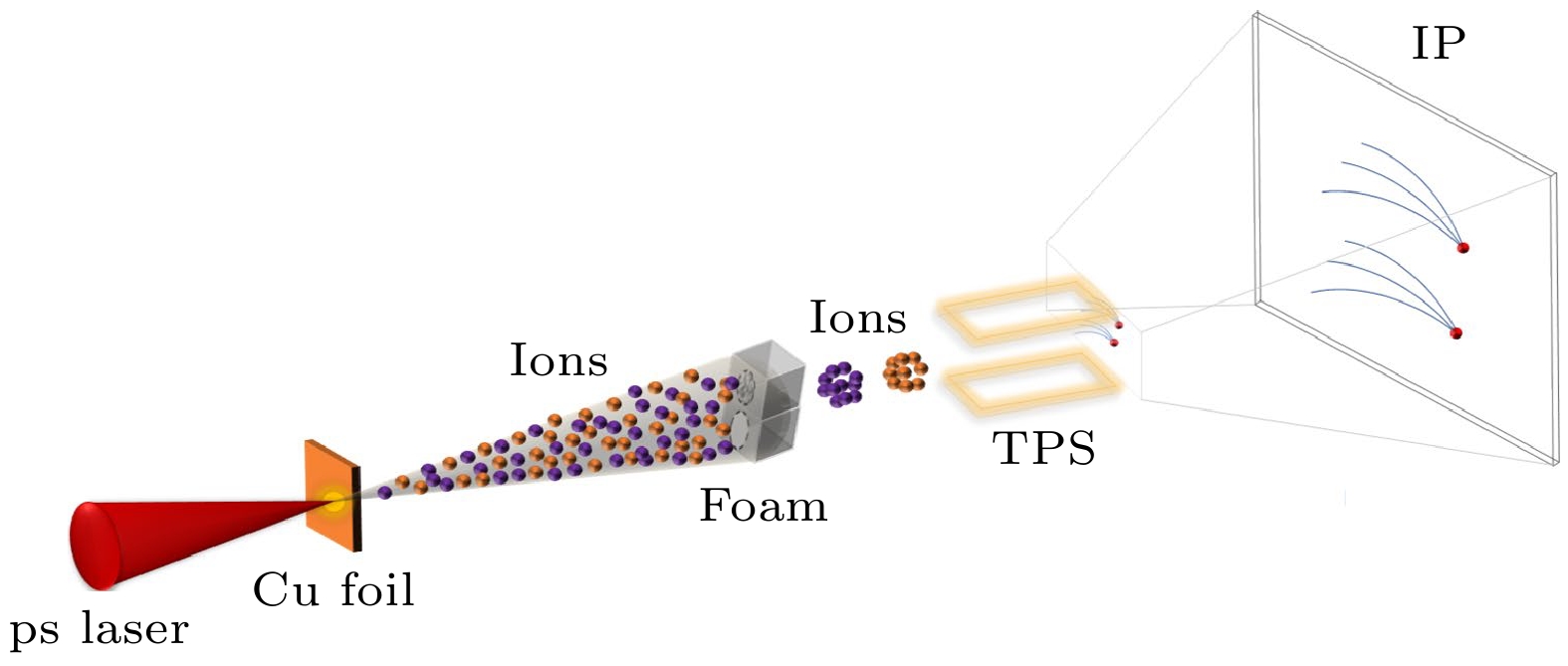
 下载:
下载:
